DPWX/Tornadic supercell thunderstorm: 7 May 2016
Author: Patrick C. Kennedy
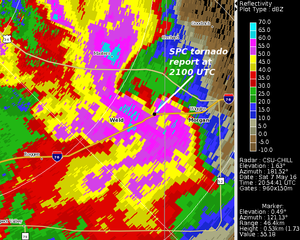
CSU-CHILL S-band reflectivity data in a 0.5 deg elevation angle PPI sweep through a tornadic hook echo on 7 May 2016. The horizontal winds in the vicinity of the associated mesocyclone at the 3 km MSL height level have been determined from a dual-Doppler analysis with input data from the CSU-CHILL and NWS KFTG radars.
Overview
Near 2100 UTC on 7 May 2016 a confirmed tornado occurred at a range of ~45 km to the southeast of the CSU-CHILL radar. The radar was conducting PPI sector volume scans of this area as the tornado developed. This article presents a few data plots selected from the early stages of the tornadic period.
Pre-warning period (2039 - 2041 UTC)
The following plot shows the CSU-CHILL reflectivity data in a 6.5 degree elevation PPI scan that ended at 2039:31 UTC. As indicated, a bounded weak echo region (BWER) was present just north of I-76, at a height of ~5 km AGL. These localized echo minima in thunderstorms occur when strong updrafts loft growing hydrometeors to higher altitudes. For geographic reference, the black dots on the shorelines of Empire Reservoir mark two of the locations where tornado damage was documented by an NWS post-storm survey.

The next plot shows the reflectivity data observed in an RHI scan taken through the BWER region on an azimuth of 121 degrees at 2041 UTC. The overhanging echo structure is evident at a range of ~45 km.
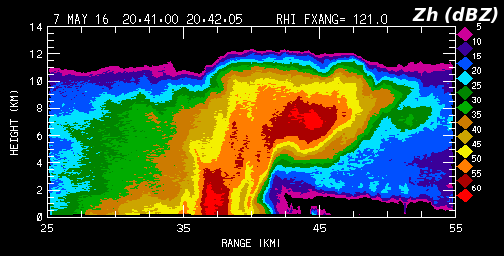
The corresponding de-aliased radial velocity field is shown in the next plot. Strong (> 35 mps) velocities inbound to the storm exist at heights below ~6 km. Divergence is indicated in the somewhat domed storm top structure near range = 43 km. This general upper level divergence, surmounting lower level convergence, implies that organized updrafts were occurring in the BWER / suspended reflectivty core near range=45 km, height=7.5 km AGL. A few minutes after this RHI scan, the NWS issued a tornado warning at 2046 UTC based on a radar indicated rotation located 5 miles west of Wiggins and moving north at 35 mph.
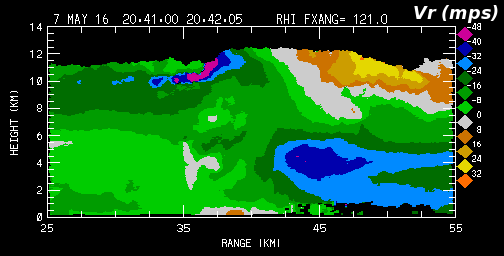
Mesocyclone observations near 2103 UTC
Severe weather spotter reports archived by the Storm Predication Center show that a multi-vortex tornado was observed crossing I-76 at 2100 UTC. The following two plots show the associated low level cyclonic rotation couplets as observed by the CSU-CHILL and NWS KFTG radars at ~2103 UTC. (For reference, three NWS damage survey points in the immediate Empire Reservoir area are marked with black dots.) The northerly storm motion was more nearly aligned with the KFTG viewing direction. As a result, the strongest radial velocities (outbound in excess of 40 mps) were seen in the KFTG data.
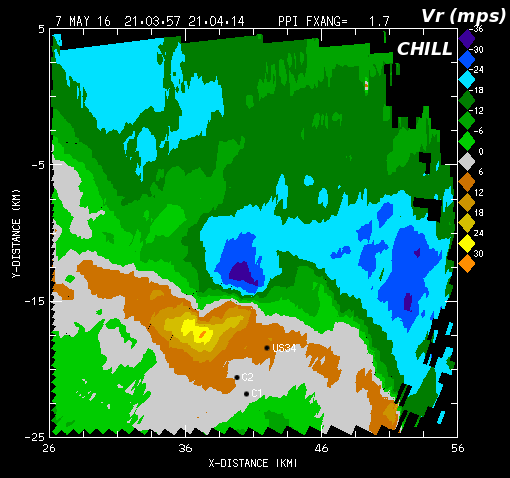
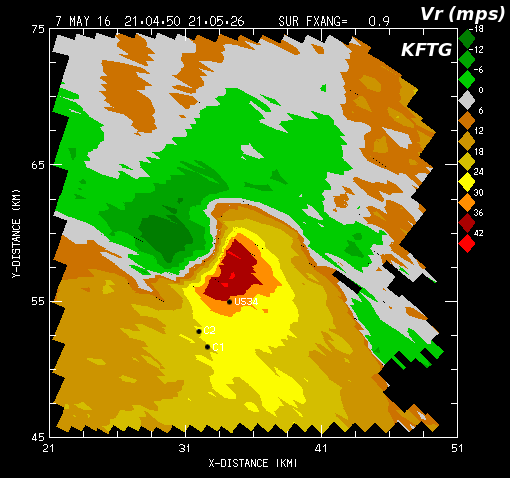
A snapshot of the horizontal winds in the mesocyclone area was developed through a dual-Doppler synthesis done using data from the volume scans that started at KFTG at 2103:56 UTC and at CSU-CHILL at 2103:40 UTC. (i.e., The same two volumes that contained the individual radar radial velocity plots show above.) The data fields from both radars, including an interactively de-aliased radial velocity field, were interpolated to a common Cartesian grid point array with a 0.5 km mesh size in X,Y, and Z. The horizontal winds were derived from the gridded radial velocities using the NCAR CEDRIC program. This wind synthesis procedure included an adjustment for the observed mesocyclone motion from 180 deg at 17 mps. Since these two radars are separated by ~75 km, the synthesized winds do not accurately represent small scale (~2-3 km or less) flow features. The next plot shows the derived Earth-relative horizontal wind vectors at the 3 km MSL height level (~1.7 km AGL) at an analysis time of 2105 UTC. The color-filled field is the CSU-CHILL reflectivity data. The mesocyclone circulation is well correlated with the hook echo pattern in the reflectivity field. The wind vectors also clearly show a convergence axis curving southeastwards from the leading edge of the mesocyclone.
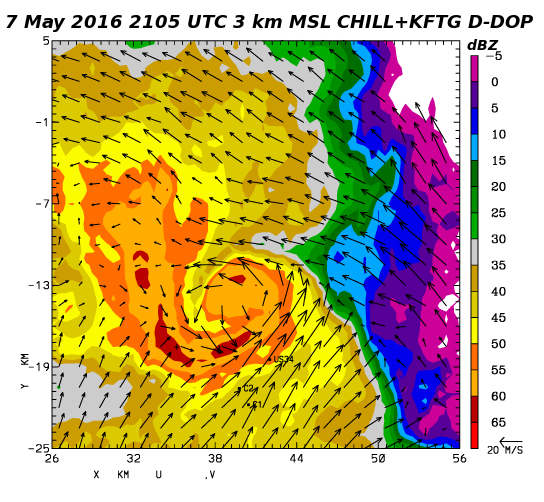
The color fill in the final plot shows the horizontal wind speeds at the 3 km MSL height level based on the vector field in the preceding plot. Three localized wind speed maxima were indicated within the general mesocyclone region. Northward storm motion probably contributed to the maxima that contained the highest speeds (> 40 mps).
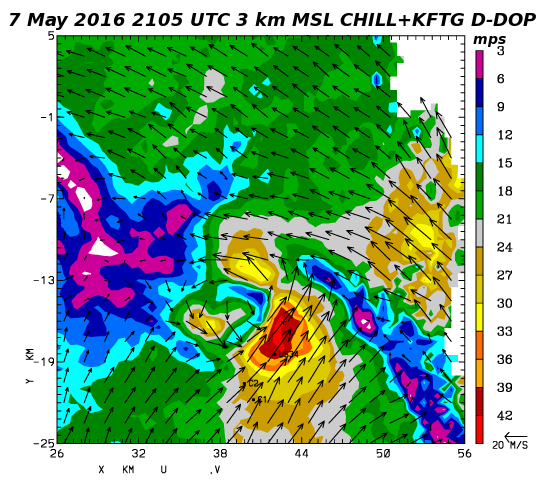
Summary
The supercell thunderstorm that produced a confirmed tornado near the Empire Reservoir during the afternoon of 7 May 2016 was well observed by both the NWS KFTG and the CSU-CHILL radars. A single, low altitude dual Doppler wind field synthesis at 2105 UTC while the tornado was in progress confirmed the presence of a large, well-defined mesocyclone. Examinations of the reflectivity, velocity, and dual polarization data fields across a wider time span should provide additional useful results.